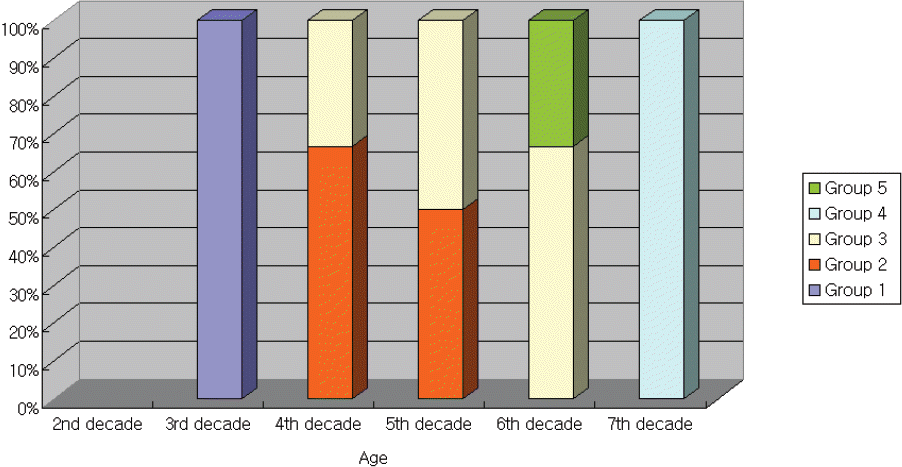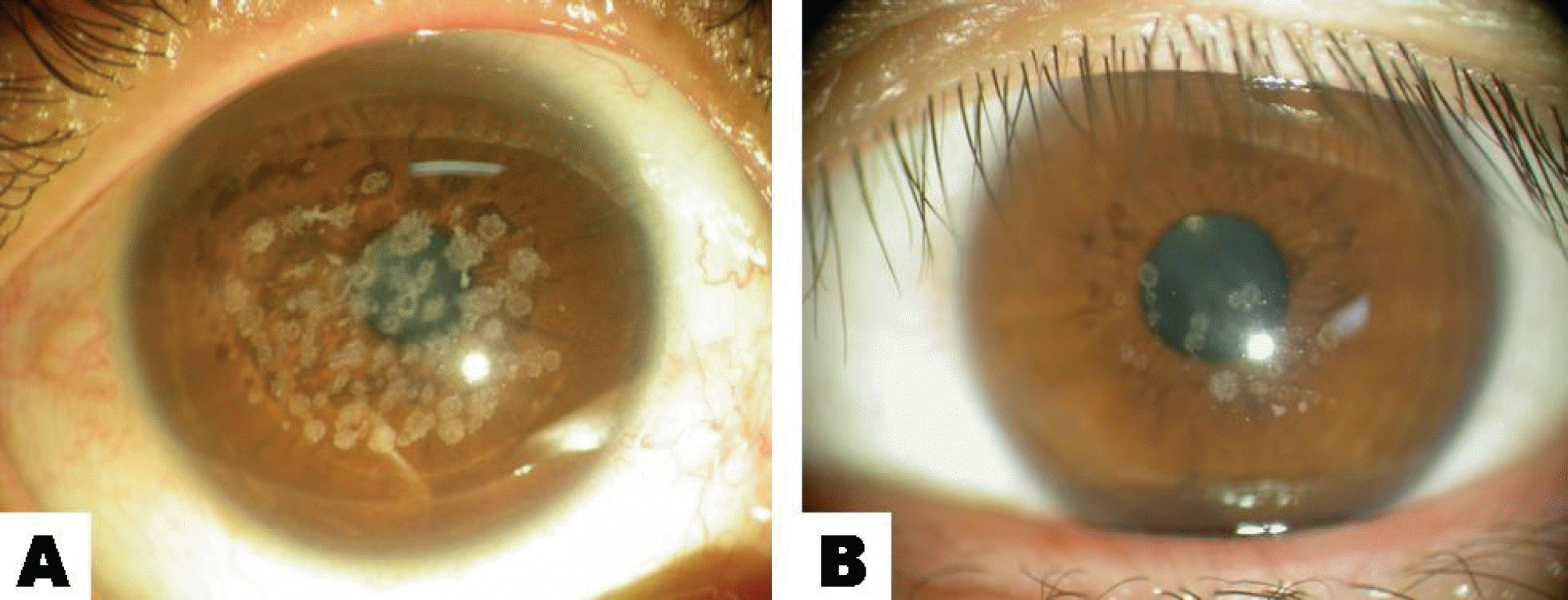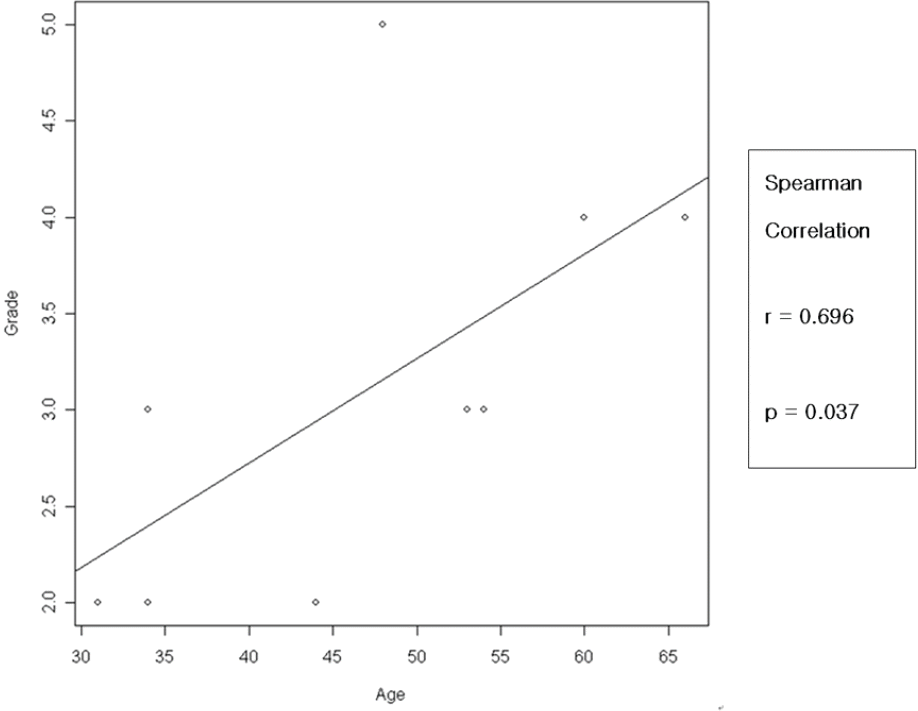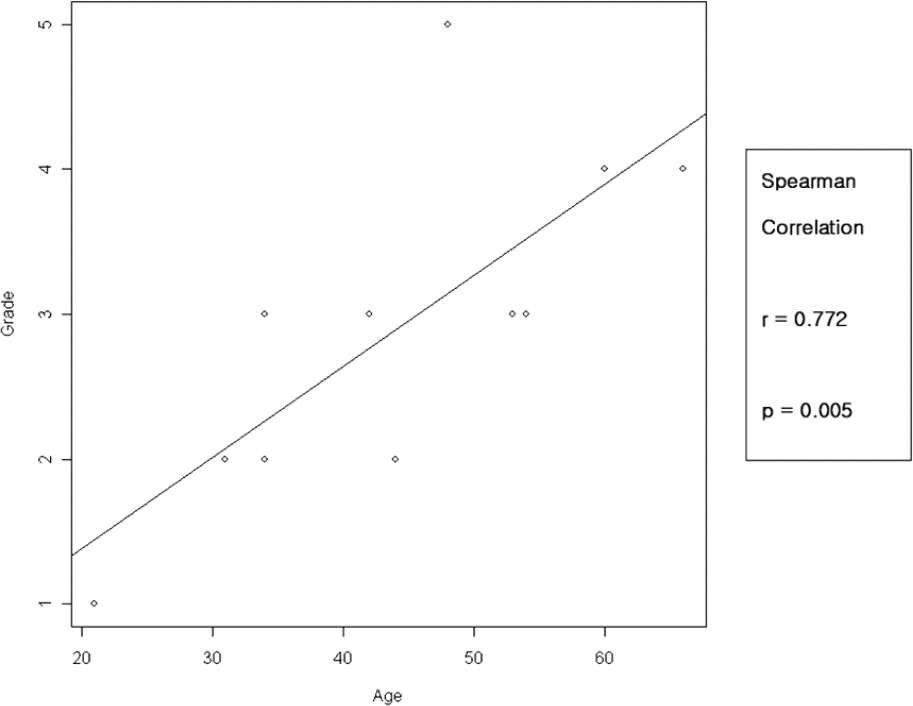Abstract
Purpose
To introduce a new genetic method for the diagnosis of Avellino corneal dystrophy (ACD), which is non-invasive and can be easily performed on an outpatient basis, and to evaluate the relationship between the degree of corneal opacity and age or sex.
Methods
A genetic study was performed on 11 patients who had a specific corneal opacity by slit-lamp examination and on four normal patients by using a specific adhesive tape to obtain epidermal keratinocytes. Corneal dystrophy was diagnosed according to the genetic study.
Results
All 11 patients were confirmed as having heterozygous ACD. Heterozygous ACD patients were classified into five stages: trace, mild, moderate, severe, or very severe, based on slit-lamp photography status. Corneal stages had no relationship with sex ( p=0.982), but the severity of ACD increased with age ( p=0.005). Conclusions: A non-invasive sticker-type genetic study kit, the “U-gene test” is a good method to diagnose corneal dystrophy genetically. Avellino corneal dystrophy becomes more severe over time but has no relationship with sex.
References
2. Pieramici SF, Afshari NA. Genetics of corneal dystrophies: the evolving landscape. Curr Opin Ophthalmol. 2006; 17:361–6.

3. Ye YF, Yao YF, Zhou P, Pan F. In vivo confocal microscopy of pre-Descemet's membrane corneal dystrophy. Clin Experiment Ophthalmol. 2006; 34:614–6.

4. Konishi M, Mashima Y, Nakamura Y. . Granular-lattice (Avellino) corneal dystrophy in Japanese patients. Cornea. 1997; 16:635–8.

5. Kim HS, Yoon SK, Cho BJ. . BIGH3 gene mutations and rapid detection in Korean patients with corneal dystrophy. Cornea. 2001; 20:844–9.

6. Kocak-Atlintas AG, Kocak-Midillioglu I, Akarsu AN, Duman S. BIGH3 gene analysis in the different diagnosis of corneal dystrophies. Cornea. 2001; 20:64–8.
7. Klintworth GK. Advances in the molecular genetics of corneal dystrophies. Am J Ophthalmol. 1999; 128:747–54.

8. Waring GO, Rodringues MM, Labison PR. Corneal dystrophies. Surv Ophthalmol. 1978; 23:71–122.
9. Cogan DG, Donaldson DD, Kuwabara T, Marshall D. Microcystic dystrophy of the corneal epithelium. Trans Am Ophthalmol Soc. 1964; 63:213–25.
10. Ferry AP, Benson WH, Weinberg RS. Combined granular- lattice (Avellino) corneal dystrophy. Trans Am Ophthalmol Soc. 1997; 95:61–77.
11. Jee DH, Lee YD, Kim MS. Epidemiology of corneal dystrophy in Korea. J Korean Ophthalmol Soc. 2003; 44:581–7.
12. Chung SH, Kim CY, Kim EK. The classification and clinical characteristics in Korean Patients with Avellino Corneal Dystrophy. J Korean Ophthalmol Soc. 2005; 46:938–44.
13. Roh MI, Grossniklaus HE, Chung SH. . Avellino corneal dystrophy exacerbated after LASIK: scanning electron microscopic findings. Cornea. 2006; 25:306–11.
Figure 1.
Showing how to use “U-gene test.” Put the sticker on the forearm about 20 seconds and peel it off.

Figure 2.
Index photographs of Avellino corneal dystrophy. Five stages based on a slit-lamp photography. (A) Trace, (B) Mild, (C) Moderate, (D) Severe, (E) Very Severe.

Figure 3.
Distribution of heterozygous Avellino corneal dystrophy according to the age. ACD aggravates as the patients become older.

Figure 5.
A slit lamp photograph showing the different stages of Avellino corneal dystrophy in the patients of similar age. (A) A 48-year-old female (B) A 42-year-old female.





 PDF
PDF ePub
ePub Citation
Citation Print
Print




 XML Download
XML Download